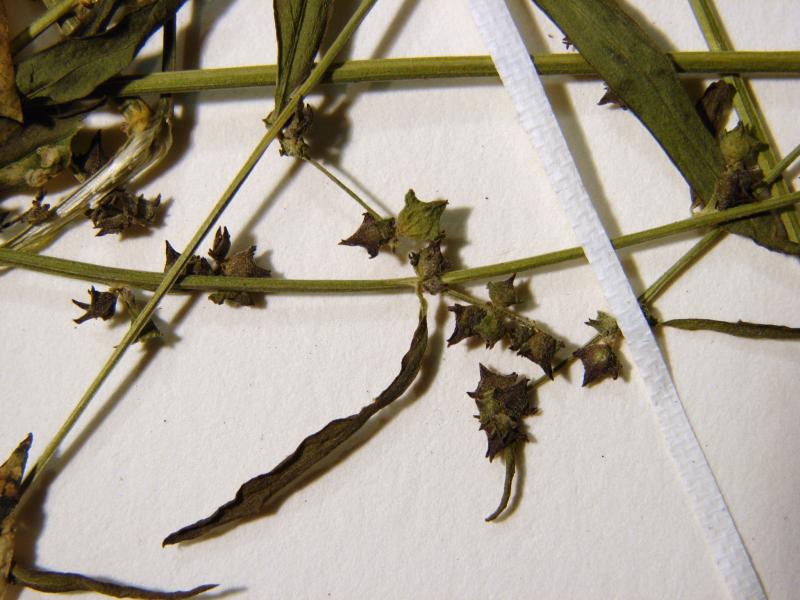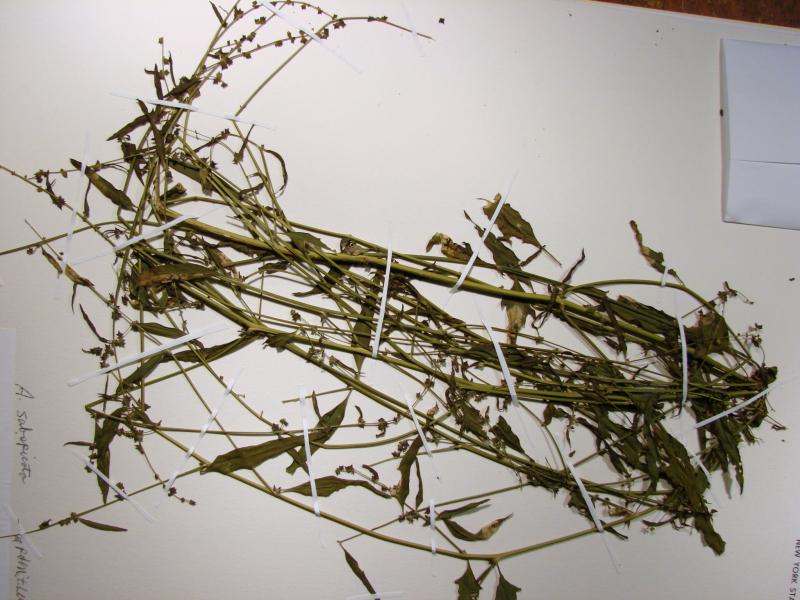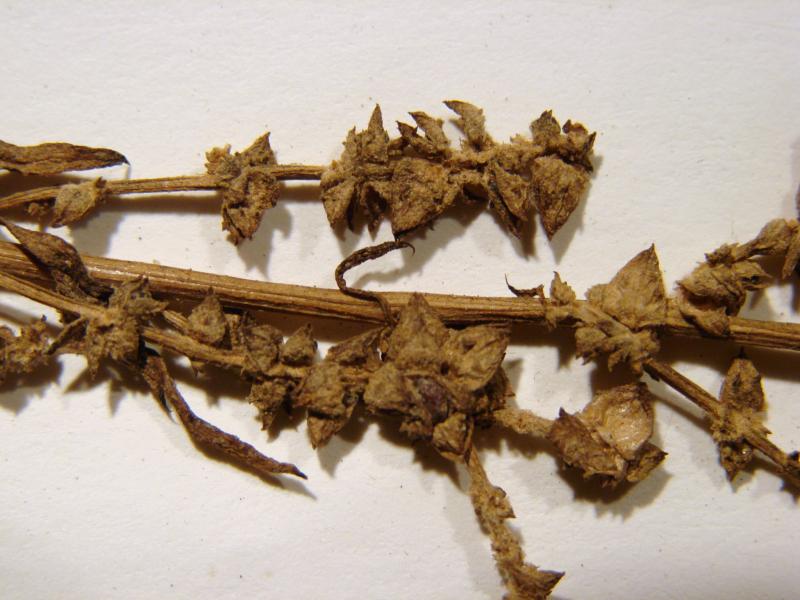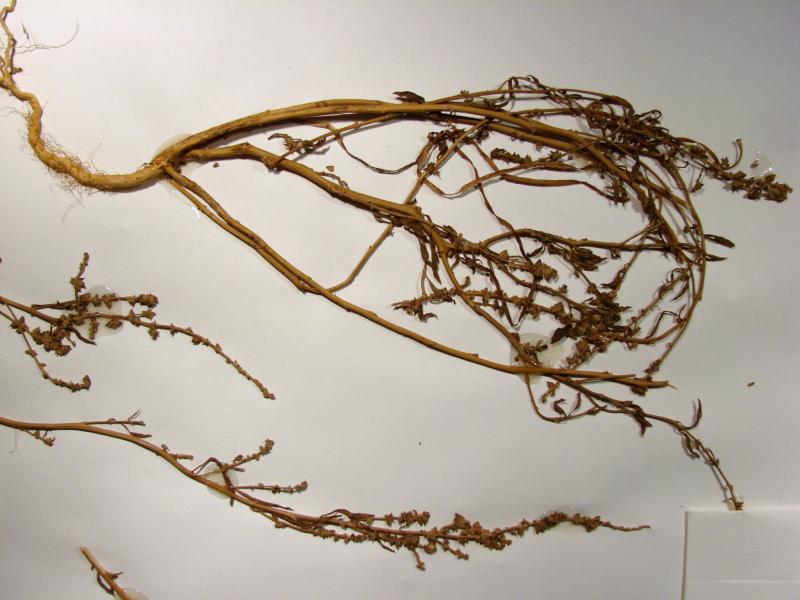Thick-leaved Orach
Atriplex dioica Raf.
- Class
- Dicotyledoneae (Dicots)
- Family
- Amaranthaceae (Amaranth Family)
- State Protection
- Endangered
Listed as Endangered by New York State: in imminent danger of extirpation in New York. For animals, taking, importation, transportation, or possession is prohibited, except under license or permit. For plants, removal or damage without the consent of the landowner is prohibited.
- Federal Protection
- Not Listed
- State Conservation Status Rank
- S1
Critically Imperiled in New York - Especially vulnerable to disappearing from New York due to extreme rarity or other factors; typically 5 or fewer populations or locations in New York, very few individuals, very restricted range, very few remaining acres (or miles of stream), and/or very steep declines.
- Global Conservation Status Rank
- G5
Secure globally - Common in the world; widespread and abundant (but may be rare in some parts of its range).
Summary
Did you know?
This species has taken advantage of the use of road salt to extend its range westward from the natural salt marshes of Long Island where it was historically known. Another species of orach, Atriplex prostrata, has been introduced from Europe and is now invading saline habitats where thickleaf orach used to grow.
State Ranking Justification
There are three existing populations along salted roadsides outside of the natural range of the species. There are three historical occurrences from salt marshes on Long Island that have not been rediscovered nor have new populations been seen on Long Island.
Short-term Trends
This plant may be doing better than we think because it is able to grow along roadsides where road salt has provided new habitat where it can survive. At the same time these areas are often disturbed by roadwork and maintenance which may destroy some populations. Existing populations have not been recently checked so short-term trends are unknown.
Long-term Trends
For native populations on Long Island the long-term trend has been negative as the few historical records have not been rediscovered. The long-term trend for this plant may be positive as the plant expands its range along roadsides where salt is used.
Conservation and Management
Threats
Threats to existing populations include roadside construction and maintenance that may directly impact populations in roadside ditches. In its native saltmarsh habitat the plants may be impacted by draining of the marshes and other hydrologic changes.
Conservation Strategies and Management Practices
After more research is done, management practices can be adjusted to maximize the success of plants growing along roadsides.
Research Needs
Research is needed to see if the species is taking advantage of road salt to expand its range significantly within New York. Research is also needed to see how roadside management practices increase or decrease the presence of this species.
Habitat
Habitat
This halophytic (salt-loving) species is known from coastal areas as well as from inland areas of saline soil. In New York it was historically collected from salt meadows and beaches, but the few known existing sites are human-impacted sites where the soils are affected by road salt (New York Natural Heritage Program 2007). Sea beaches, and also commonly inland in saline habitats (Gleason & Cronquist 1991). Saline and alkaline soils in waste places (Clemants 1992).
Associated Ecological Communities
- Brackish meadow*
(guide)
A moist, moderately well-drained brackish (salinity 0.5-18 ppt) perennial grassland with occasional isolated shrubs that is typically situated in a belt at the upper edge of salt marshes bordering sandy uplands, but may occupy large portions of interdunal basins. The community usually develops in areas with a unique combination of soils and hydrology, on deep deposits of periodically windblown or overwashed gleyed sands that are usually flooded only during spring tides and during major coastal storms, approximately two to three times per year.
- Brackish tidal marsh*
(guide)
A marsh community that occurs where water salinity ranges from 0.5 to 18.0 ppt, and water is less than 2 m (6 ft) deep at high tide. The vegetation in a brackish tidal marsh is dense and dominated by tall grass-like plants.
- Estuarine common reed marsh*
A tidal marsh dominated by non-native reedgrass (Phragmites australis). Estuarine reedgrass marshes may become established in tidal freshwater, brackish, and salt marsh settings. Establishment usually follows alteration of the original marsh through impacts such as dredging, ditching, or impounding water.
- High salt marsh*
(guide)
A coastal marsh community that occurs in sheltered areas of the seacoast, in a zone extending from mean high tide up to the limit of spring tides. It is periodically flooded by spring tides and flood tides. High salt marshes typically consist of a mosaic of patches that are mostly dominated by a single graminoid species.
- Low salt marsh*
(guide)
A coastal marsh community that occurs in sheltered areas of the seacoast, in a zone extending from mean high tide down to mean sea level or to about 2 m (6 ft) below mean high tide. It is regularly flooded by semidiurnal tides. The mean tidal range of low salt marshes on Long Island is about 80 cm, and they often form in basins with a depth of 1.6 m or greater.
- Maritime beach
(guide)
A community with extremely sparse vegetation that occurs on unstable sand, gravel, or cobble ocean shores above mean high tide, where the shore is modified by storm waves and wind erosion.
- Mowed roadside/pathway
A narrow strip of mowed vegetation along the side of a road, or a mowed pathway through taller vegetation (e.g., meadows, old fields, woodlands, forests), or along utility right-of-way corridors (e.g., power lines, telephone lines, gas pipelines). The vegetation in these mowed strips and paths may be dominated by grasses, sedges, and rushes; or it may be dominated by forbs, vines, and low shrubs that can tolerate infrequent mowing.
- Salt panne*
(guide)
A shallow depression in a salt marsh where the marsh is poorly drained. Pannes occur in both low and high salt marshes. Pannes in low salt marshes usually lack vegetation, and the substrate is a soft, silty mud. Pannes in a high salt marsh are irregularly flooded by spring tides or flood tides, but the water does not drain into tidal creeks. After a panne has been flooded the standing water evaporates and the salinity of the soil water is raised well above the salinity of sea-water.
- Salt shrub*
(guide)
A shrubland community that forms the ecotone between salt marsh and upland vegetation. Salinity levels are generally lower here than in the salt marsh (soil pore salinity ranges 7 ppt to 27 ppt), and the elevation is higher. Salt shrub does not usually develop on deep peat. More often, it occurs on a thin (0-10 cm) layer of peat, and soils share characteristics of both estuarine and maritime terrestrial settings.
* probable association but not confirmed.
Associated Species
- Spergularia maritima
Range
New York State Distribution
This plant is currently known in New York from a few sites in Orange and Ontario counties. Historically it was also collected from New York City and Long Island.
Global Distribution
In North America Thickleaf Orach is widespread in the Rocky Mountain and Great Basin regions, and also known from scattered locations in New York and New England, the Pacific Coast, Hudson Bay, and the Canadian Maritime provinces.
Identification Comments
General Description
Thickleaf Orach is an herbaceous species growing up to 5 feet tall. The leaves range from lanceolate to linear-lanceolate to often broadly triangular, are thickened and scurfy, and are subtended by smaller, bracteoles (miniature leaves) which often have a spongy inner layer. The flowers are unisexual, without a perianth (petals or sepals), and are usually obscured by a pair of bracteoles. This species has brown seeds 1.5-3 mm wide (and wider than long). The mature seeds have the radicle median, ascending to pointing outward with the apex curved inward.
Identifying Characteristics
Best Life Stage for Proper Identification
For identification to species, specimens with mature fruit are needed.
Similar Species
In New York, Atriplex dioica is most difficult to distinguish from Atriplex patula L. (sensu stricta), which has linear-lanceolate to lanceolate leaves and rhombic-triangular to triangular-hastate bracteoles, always thin and lacking a spongy inner layer. The seeds are brown, round, 2.5-3.1 (3.7) mm wide, round, and the radicle sub-basal, ascending with a pointed apex.
Best Time to See
Thickleaf Orach flowers in August and fruits from September to mid-November.
- Flowering
- Fruiting
The time of year you would expect to find Thick-leaved Orach flowering and fruiting in New York.
Thick-leaved Orach Images
Taxonomy
Thick-leaved Orach
Atriplex dioica Raf.
- Kingdom Plantae
- Phylum Anthophyta
- Class Dicotyledoneae
(Dicots)
- Order Caryophyllales
- Family Amaranthaceae (Amaranth Family)
- Order Caryophyllales
- Class Dicotyledoneae
(Dicots)
- Phylum Anthophyta
Additional Common Names
- Orach
- Orache
- Spearscale
- Suckley's endolepis
- Thickleaf Orach
Synonyms
- Atriplex patula ssp. spicata (S. Wats.) Hall & Clements
- Atriplex patula var. subspicata (Nutt.) S. Watson
- Atriplex subspicata (Nutt.) Rydb.
Additional Resources
Best Identification Reference
Flora of North America Editorial Committee. 2003. Flora of North America North of Mexico, Volume 4, Magnoliophyta: Caryophyllidae, Part 1. Oxford University Press, New York.
Other References
Clemants, Steven E. 1992. Chenopodiaceae and Amaranthaceae of New York State. Bulletin No. 485. New York State Museum. Albany, NY.
Fernald, M.L. 1950. Gray's manual of botany. 8th edition. D. Van Nostrand, New York. 1632 pp.
Gleason, Henry A. and A. Cronquist. 1991. Manual of Vascular Plants of Northeastern United States and Adjacent Canada. The New York Botanical Garden, Bronx, New York. 910 pp.
Holmgren, Noel. 1998. The Illustrated Companion to Gleason and Cronquist's Manual. Illustrations of the Vascular Plants of Northeastern United States and Adjacent Canada. The New York Botanical Garden, Bronx, New York.
New York Natural Heritage Program. 2010. Biotics database. New York Natural Heritage Program. New York State Department of Environmental Conservation. Albany, NY.
New York Natural Heritage Program. 2024. New York Natural Heritage Program Databases. Albany, NY.
Weldy, T. and D. Werier. 2010. New York flora atlas. [S.M. Landry, K.N. Campbell, and L.D. Mabe (original application development), Florida Center for Community Design and Research http://www.fccdr.usf.edu/. University of South Florida http://www.usf.edu/]. New York Flora Association http://newyork.plantatlas.usf.edu/, Albany, New York
Weldy, Troy W. and David Werier. 2005. New York Flora Atlas. [S.M. Landry, K.N. Campbell, and L.D. Mabe (original application development), Florida Center for Community Design and Research. University of South Florida]. New York Flora Association, Albany, NY. Available on the web at (http://newyork.plantatlas.usf.edu/).
Links
About This Guide
Information for this guide was last updated on: January 18, 2008
Please cite this page as:
New York Natural Heritage Program. 2024.
Online Conservation Guide for
Atriplex dioica.
Available from: https://guides.nynhp.org/thickleaf-orach/.
Accessed July 26, 2024.






